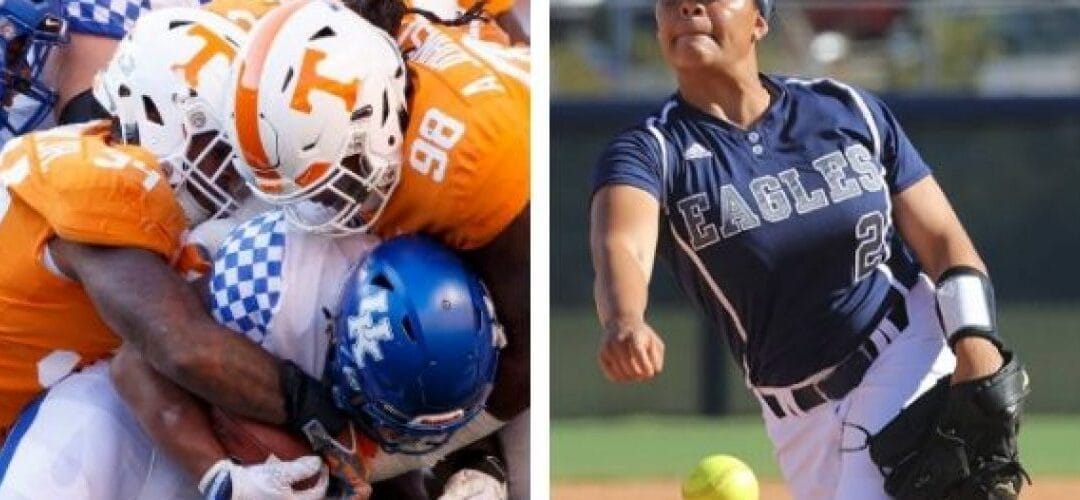By Paul Culp, MA (Oxon.), CFT, GCDF, CCSP
Our series on athletic scholarships has covered eight different sports so far, in addition to our more general posts on The “How Many” and “How Much” of Athletic Scholarships and The “How To” of Athletic Scholarships Explained. Each sport-specific article explains whether that sport is a head-count sport or an equivalency sport, and what the difference is. We’ll continue to do that, but now we’re also going to collect that type of information into one tidy little article, along with a simple arithmetic lesson.
Head-count sports and equivalency sports defined:
Head-count sports are what most people are thinking about when they think about athletic scholarships—one athlete, one scholarship, a full free ride. Equivalency scholarships are those that can be divided among as many athletes as the coach desires. The most extreme example we’ve encountered so far, which we noted in our article on track scholarships, was a program that distributed 12.6 scholarships (the maximum permitted) among 59 athletes (in a sport with no roster limits).
Full rides do occur in equivalency sports. That’s up to the coach. But most athletes in those sports receive only partial funding, which can be combined with other forms of financial aid.
Which sports are the head-count sports?
The head-count system occurs only in NCAA Division I, and in only a handful of sports: football (FBS only), men’s basketball, women’s basketball, and women’s gymnastics, tennis, and volleyball.
That’s it. In all this great land of ours, there are only two men’s collegiate sports in which all of the scholarships are full rides.
Which leaves us with…
Equivalency sports comprise all the other Division I sports, including FCS football, plus all of Division II, the entire NAIA, and all junior colleges.
Comparison shopping is crucial.
If a college offers you a scholarship on a head-count basis, or if you are one of the lucky few athletes who are offered a full scholarship in an equivalency-sport situation, things are pretty simple. The equivalency scholarship scene on the other hand can require a bit of mental exertion.
Scholarship limits are per program, not per year. For instance, Division I women’s lacrosse teams are allowed 12 at a time, regardless of how many athletes are leaving the program (via graduation or otherwise) or arriving as incoming freshman. If you are being courted by coaches from multiple schools in an equivalency sport, what they can offer you may vary considerably. For example, if you would be one of ten incoming freshmen in a program that has lost only four seniors, your position is not as favorable as if you would be one of six freshmen entering a program that just graduated seven. It’s essential to ask plenty of questions and make absolutely sure of what you’re doing.
And of course there’s the question of value, and it can be surprisingly easy to lose sight of this amid all the rhetoric about signing up. Let’s say you’re offered a half-scholarship at Balderdash College, where tuition per annum is $30,000. Your out-of-pocket would therefore be $15,000. You also have a measly 20 percent scholarship offer from Wheewhonka Tech, where tuition is $15,000. That scholarship would save you $3,000 and leave you with $12,000 out-of-pocket. All other things being equal, a small scholarship at Wheewhonka is a better value than a big one at Balderdash, even if it’s not as fun to brag about.
Coming up in the world…
But don’t be discouraged. For many athletes in equivalency sports, the pie slice gets larger as they gain seniority and value in the program. A small scholarship can evolve into a large one over time.
And coming back down…
Never forget that whether you’re in a head-count sport or an equivalency sport, your scholarship isn’t necessarily permanent. Though the conditions under which a scholarship can be revoked are carefully regulated, athletic scholarships are renewable on a year-to-year basis.
Sports and your transcript…
It should be obvious by now that most scholarship athletes need additional forms of financial aid in order to manage the cost of college. Though there certainly is such a thing as a dumb jock, coaches in head-count sports and equivalency sports alike prefer strong students who can be depended upon not to run into eligibility problems because of academic deficiency. For athletes in equivalency sports, a strong academic record can also lead to academic scholarships that combine nicely with partial athletic scholarships to make a collegiate athletic career possible.
We at The Coaching Educator cannot emphasize strongly enough the importance of having a strategy not only for pursuing athletic scholarships but also for combining them with other forms of financial aid. A decade of experience helps us help you stay on schedule and on task, in contact with the right people, and within the rules. We’re here to help students and their families make sense of an increasingly complicated procedure and find ways to overcome the ever-increasing expense of college for athletes and non-athletes alike.
To learn more about our philosophy and capabilities, be sure to watch our free webinars, listen to our podcasts, sign up for our four-week College App Boot Camp, consider our Ultimate Programs and our special services for athletes and performing-arts students, and book a consultation to hear what we can do for you and how we do it. Keep reading this blog, and look for us on social media (see links below) as we keep our clients and admirers advised of new developments in our effort to help students get into and succeed at the right school.
Paul Culp is certified as a global career development facilitator and writes about college admissions, college costs, financial aid, and college life in general for The Coaching Educator team. A former journalist and corporate ghostwriter who now operates Shenandoah Proofreading, Editing & Composition Services (SPECS), he has also been a humanities teacher at all levels from university down to sixth grade. Paul has degrees from Oxford University, Jacksonville State University, and Samford University, and also is certified as a fitness trainer.
Photos: Tennessee football and Georgia-Southern softball
Recommended Reading About College Admissions and Athletic Scholarships
Culp, Paul. “An Arm and a Leg and Your First-born Child: Why College Costs So Much, The Coaching Educator, http://tce.local/2018/09/06/an-arm-and-a-leg-and-your-first-born-child-why-college-costs-so-much/
Culp, Paul. “Baseball Scholarships by the Numbers,” The Coaching Educator, 15 April 2019, http://tce.local/2019/04/15/baseball-scholarships-by-the-numbers/
Culp, Paul. “Basketball Scholarships by the Numbers,” The Coaching Educator, 4 April 2019, http://tce.local/2019/04/04/basketball-scholarships-by-the-numbers/
Culp, Paul. “Football Scholarships by the Numbers,” The Coaching Educator, 17 April 2019, http://tce.local/2019/04/17/football-scholarships-by-the-numbers/
Culp, Paul. “Golf Scholarships by the Numbers,” The Coaching Educator, 3 May 2019, http://tce.local/2019/05/03/golf-scholarships-by-the-numbers/
, Paul. “The ‘How Many’ and ‘How Much’ of Athletic Scholarships,” The Coaching Educator, 18 September 2018, http://tce.local/2018/09/18/the-how-many-and-how-much-of-athletic-scholarships/
Culp, Paul. “The ‘How To’ of Athletic Scholarships Explained,” The Coaching Educator, 24 November 2018, http://tce.local/2018/11/24/the-how-to-of-athletic-scholarships-explained/
Culp, Paul. “Lacrosse Scholarships by the Numbers,” The Coaching Educator, 6 December 2018, http://tce.local/2018/12/06/lacrosse-scholarships-by-the-numbers/
Culp, Paul. “Ten Unusual Athletic Scholarships, The Coaching Educator, 8 March 2019, http://tce.local/2019/04/08/ten-unusual-athletic-scholarships/
Culp. Paul. “Track Scholarships by the Numbers,” The Coaching Educator, 21 May 2019, http://tce.local/2019/05/21/track-scholarships-by-the-numbers/
Culp, Paul. “Why Scholarship Athletes Quit,” The Coaching Educator, 25 February 2019, http://tce.local/2019/02/25/why-scholarship-athletes-quit/
Culp, Paul. “Women’s Soccer Scholarships by the Numbers,” The Coaching Educator, 23 October 2018, http://tce.local/2018/10/23/womens-soccer-scholarships-by-the-numbers/?fbclid=IwAR1tqZ-uyy8Kjw8krJDl–ERyuxUF_lt2uVfcqFqbNtmQDDTQvvBK7EOhJ8
Culp, Paul. “Women’s Volleyball Scholarships by the Numbers,” The Coaching Educator, 10 October 2018, http://tce.local/2018/10/10/womens-volleyball-scholarships-by-the-numbers/

